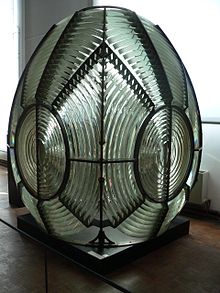
Back Fresnel-Linse ALS عدسة فرينل Arabic Lente de Fresnel AST Френель линзаһы Bashkir Френелова леща Bulgarian Lent de Fresnel Catalan Fresnelova čočka Czech Fresnellinse Danish Fresnel-Linse German Fresnel-lenso Esperanto

A Fresnel lens (/ˈfreɪnɛl, -nəl/ FRAY-nel, -nəl; /ˈfrɛnɛl, -əl/ FREN-el, -əl; or /freɪˈnɛl/ fray-NEL[1]) is a type of composite compact lens which reduces the amount of material required compared to a conventional lens by dividing the lens into a set of concentric annular sections.
The simpler dioptric (purely refractive) form of the lens was first proposed by Georges-Louis Leclerc, Comte de Buffon[2], and independently reinvented by the French physicist Augustin-Jean Fresnel (1788–1827) for use in lighthouses.[3][4] The catadioptric (combining refraction and reflection) form of the lens, entirely invented by Fresnel, has outer prismatic elements that use total internal reflection as well as refraction to capture more oblique light from the light source and add it to the beam, making it visible at greater distances.
The design allows the construction of lenses of large aperture and short focal length without the mass and volume of material that would be required by a lens of conventional design. A Fresnel lens can be made much thinner than a comparable conventional lens, in some cases taking the form of a flat sheet.
Because of its use in lighthouses, it has been called "the invention that saved a million ships".[5]
- ^ J. Wells (3 April 2008), Longman Pronunciation Dictionary (3rd ed.), Pearson Longman, ISBN 978-1-4058-8118-0.
- ^ Cite error: The named reference
chisholm-1911-lighthousewas invoked but never defined (see the help page). - ^ "Fresnel lens", Merriam-Webster, archived from the original on 17 December 2013, retrieved 19 March 2013.
- ^ Wells, John (3 April 2008), Longman Pronunciation Dictionary (3rd ed.), Pearson Longman, ISBN 978-1-4058-8118-0.
- ^ Bernhard, Adrienne (21 June 2019), "The invention that saved a million ships", BBC, retrieved 4 August 2019.